- They couldn’t save their daughters’ lives in the July 4 floods. Now they’re dealing with the grief and the guilt.
- Austin could see heavy rains, possible flooding over the next few days
- Families of campers, counselors who died in Texas Hill County floods sue Camp Mystic
- Small plane bound for Jamaica with hurricane relief supplies crashes in Florida neighborhood
- Ask the Meteorologist: Did a tornado hit Johnston County Saturday night?
Amid hurricane season, NWS gets green light to hire meteorologists, CNN reports

The NWS got emergency clearance to hire 125 meteorologists amid a critical staffing shortage during the active hurricane season.
HOUSTON — The National Weather Service has received emergency clearance to hire roughly 125 new meteorologists and specialists, CNN reports, following months of growing concern over critical staffing shortages and an active hurricane season already underway.
Citing unnamed sources, CNN says the temporary lift of a federal hiring freeze could help forecast offices currently unable to staff overnight shifts or operate 24/7 — a situation impacting several offices, including ones in Goodland, Kansas, and Sacramento, California.
It’s unclear if the Houston-Galveston area office will benefit from the new hires. That facility, located in League City, has been operating without a meteorologist in charge and with nearly half its forecast staff missing, according to recent reports from both KHOU 11 and CNN.
The new hiring plan follows the loss of more than 560 National Weather Service employees earlier this year due to early retirements and layoffs. Forecast offices across the country have struggled to fill those gaps while managing an uptick in deadly weather events, including recent tornado outbreaks in the Midwest and South.
Experts previously warned that short staffing could reduce the accuracy of forecasts and delay emergency decisions. In a May 21 webinar hosted by Rep. Lizzie Fletcher, former NOAA Administrator Dr. Rick Spinrad said the NWS is operating with 30% fewer staff than normal and has 700 additional vacancies that have gone unfilled due to the hiring freeze.
“Because we have fewer people and a higher probability of not being able to collect the data,” Spinrad said, “we will see degraded quality forecasts.” That could mean a wider “cone of uncertainty” when tracking hurricanes and more uncertainty in pinpointing landfall, especially troubling for storm-prone areas like Houston.
The recent CNN report notes that while the NWS is preparing to hire 125 people, those hires will come after the agency processes transfers to cover “critical” vacancies. Last month, NOAA announced it was seeking 155 internal transfers from well-staffed offices to help cover those gaps.
An unnamed NWS employee told CNN that while many transfer applications have been submitted, it’s too early to know whether all positions will be filled.
In addition to meteorologists, the new hiring wave may include radar technicians, hydrologists, and physical scientists, according to former NOAA employee Tom Di Liberto.
Staffing issues have also led to a decline in weather balloon launches — vital for collecting upper-air data that fuels forecast models. More personnel could mean more consistent launches and higher-quality predictions, especially during fast-changing tropical events.
The NWS is also pushing for broader hiring authority under a public safety exemption. If approved, it could help the agency recover more of the estimated 1,200 staff lost in recent years. Lawmakers have signaled support for that exemption.
As of Sunday, the 2025 Atlantic hurricane season is officially underway. While federal agencies move to address the NWS staffing crisis, local leaders like Harris County Emergency Management Coordinator Mark Sloan continue to stress the importance of public readiness.
“Doing more with less has never worked,” Sloan said.